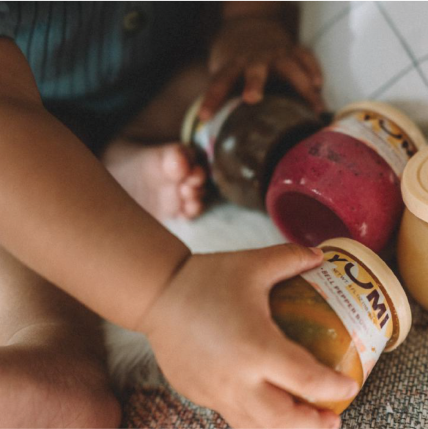
Building a Healthier Generation
Fighting for Standards from Day One
In 2021, YUMI became the first baby food company to sign the Baby Food Safety Act, which calls on the FDA to impose safety requirements on infant and toddler foods. Our co-founders traveled to Capitol Hill to meet with senators and push for stricter standards. Through open communication and continued research, we can improve safety and reduce heavy metals in baby food products.
What You Need To Know About Heavy Metals in Baby Food:
1. What Are Heavy Metals?
Key Takeaways: A heavy metal is a metal known for its toxicity. Arsenic, lead, cadmium, and mercury are amongst the most common found in food products. A 2021 Congressional Report warned consumers of these and other toxins in many popular retail brands for babies and toddlers. While trace amounts may be in our water and air, there is scientific evidence that babies are especially vulnerable and regular exposure can negatively impact neurological development.
The Most Recent News And Reports
In February 2021, The US House of Representatives Subcommittee on Economic and Consumer Policy released a report on Heavy Metals in Baby Foods – specifically arsenic, cadmium, lead, and mercury. The report found that “commercial baby foods are tainted with significant levels of toxic heavy metals, including arsenic, lead, cadmium, and mercury.”
The report called for sweeping reforms including the phasing out of certain ingredients, such as rice, in baby food products, regular testing of ingredients and final products, and for the establishment of federal limits for heavy metals in baby food products.
A national investigation of popular baby food products highlighted the need to set federal standards and urged parents to avoid rice baby food products.
In an exclusive report for CNN, Healthy Babies, Bright Futures tested 288 foods bought at stores and farmers markets across the United States.
2024 Closer to Zero Initiative
Led by the U.S. Food and Drug Administration (FDA), Closer to Zero is aimed at reducing toxic elements, such as arsenic, lead, cadmium, and mercury, in foods consumed by babies and young children. The ultimate goal is to continually lower the levels of toxic elements in children’s diets while maintaining nutrient quality, ensuring food safety, and addressing public health concerns.
From the experts
Doctors And Nutritionists Weigh In On The Latest Heavy Metal News
2. How Do Heavy Metals Get Into Baby Food?
Key Takeaways: It is a myth that you can avoid heavy metals by just buying organic foods or cooking at home. The most common source is soil, including soil from organic farms. Other potential sources include artificial additives and certain manufacturing processes.
Soil is the most common pathway. Many heavy metals still make their way to plants even in organic soil. That’s because contaminated water run-off, not pesticides, are the common cause of metals in soil. Foods take up metals like lead and arsenic from the soil and water. Some foods are especially efficient at pulling heavy metals from the soil. Consumers are also exposed to heavy metals through other routes, including the trace amounts in air and contaminated water.
According to the 2021 Congressional Report, the use of certain artificial additives was linked to high heavy metal results in baby food products. The report recommended that companies regularly test their final products to minimize this risk.
Contaminants are caused by contaminated cooking water, metals used in the food processing equipment (especially older equipment), over-processing, and overheating certain foods. In other words, how your baby’s food is made is as important as what it is made of.
Counteract Heavy Metals
Recipes and Ingredients that Combat Heavy Metal Contamination
3. What Can I Do?
Key Takeaways: Rest assured there are a number of steps that can ease your mind and reduce exposure.
Here Are A Few Ways
Rice is a leading source of arsenic exposure for young children. Limiting rice from a baby’s diet will dramatically reduce arsenic exposure. All three major reports, including the recent Congressional 2021 report, recommended the reduction of rice-based baby food products, noting that rice is one of the most common ingredients for commercially-made baby food.
While brown rice is typically considered healthier than white rice, it’s important to note that brown rice typically tests higher for arsenic. This is because heavy metals are primarily found in the bran layer of rice, which is removed in white rice.
Commercially produced juice, meanwhile, has been linked to higher readings of arsenic and lead. An investigation by Consumer Reports 2019 found cadmium, arsenic, and lead in popular fruit juices. Due to the high sugar content, the American Academy of Pediatrics recommends no juice before 1 and then very limited amounts from age 1 to 3.
Whether you’re cooking or buying baby food, try to expose your child to a wide variety of ingredients. Variety ensures your child is not relying on a singular source of nutrition that could be high in heavy metals. A varied diet of real, wholesome foods has a wide range of benefits, including training your baby to reach for veggies instead of sweets, greater exposure to nutrients, and the promotion of a healthier gut biome.
Some foods actually help limit the absorption of heavy metals in the body.
Binders attach themselves to heavy metals and assist in their removal from the digestive tract. Good examples include tomatoes, blueberries, and spirulina.
Blockers, meanwhile, help block the absorption of heavy metals. Specific nutrients, such as iron and calcium, are popular blockers. Vitamin C helps boost absorption of iron, so we recommend serving iron-rich foods (broccoli, beans, and spinach) with foods rich in vitamin C (kiwis, papayas, peppers, and tomatoes).
Learn more about this in our book, First Bites, a best-seller on Amazon.
For detailed information on specific product purchased please enter your Lot Code below.
4. What Can The Industry Do?
Key Takeaways: Under its Closer to Zero initiative, the FDA is working to set limits that reduce toxic elements like arsenic, cadmium, lead, and mercury in baby and toddler foods. Additionally companies must conduct their own tests, holding themselves to strict internal standards, while continuing the fight to reduce exposure to toxins.
The Most Recent News And Reports
In 2017, the FDA established a Toxic Elements Working Group tasked with looking at heavy metals and other contaminants in food. For more details, you can explore the FDA’s resources on the Closer to Zero program here.
It is common practice to test ingredients prior to use in baby foods. However, as noted above, artificial additives and the manufacturing process can drastically alter the end result of the product. The baby food industry must make it common practice to test both ingredients and final product.
Sources
- House Oversight Committee.“Baby Foods Are Tainted with Dangerous Levels of Arsenic, Lead, Cadmium, and Mercury.” PDF File. February 4, 2021.
- Jane Houlihan, MSCE, Research Director, and Charlotte Brody, RN, National Director, Healthy Babies Bright Futures. “What’s In My Baby’s Food.” October 2019. PDF File.
- Hirsch, J. (2018, August 16). Heavy metals in baby food: What you need to know. Retrieved March 04, 2021
- Pew Research Center. “10 Policies to Prevent and Respond to Childhood Lead Exposure.” PDF File. August 2017.
- Vahter M, Skröder H, Rahman SM, Levi M, Hamadani JD, Kippler M. Prenatal and childhood arsenic exposure through drinking water and food and cognitive abilities at 10 years of age: a prospective cohort study. Environment international. 2020;139:105723
- Tolins, M., Ruchirawat, M., & Landrigan, P. (2014, November 25). The developmental neurotoxicity of arsenic: Cognitive and behavioral consequences of early life exposure. Retrieved March 04, 2021
- JD Hamadani, F Tofail, B Nermell, R Gardner, S Shiraji, M Bottai, SE Arifeen, SN Huda, M Vahter, Critical windows of exposure for arsenic-associated impairment of cognitive function in pre-school girls and boys: a population-based cohort study, International Journal of Epidemiology, Volume 40, Issue 6, December 2011, Pages 1593–1604
- Nagaraja TN, Desiraju T. Effects on operant learning and brain acetylcholine esterase activity in rats following chronic inorganic arsenic intake. Hum Exp Toxicol 1994;13:353e6.
- Tsai SY, Chou HY, The HW, Chen CM, Chen CJ. The effects of chronic arsenic exposure from drinking water on the neurobehavioral development in adolescence. Neurotoxicology 2003;24:747e53
- Rodríguez-Barranco M, Lacasana M, et al. Association of arsenic, cadmium and manganese exposure with neurodevelopment and behavioral disorders in children: A systematic review and meta- analysis. Sci Total Environ 2013;454-455:562e77.
- Gale CR, O’Callaghan FJ, Bredow M, Martyn CN. The influence of head growth in fetal life, infancy, and child- hood on intelligence at the ages of 4 and 8 years. Pediatrics 2006;118:1486e92.






